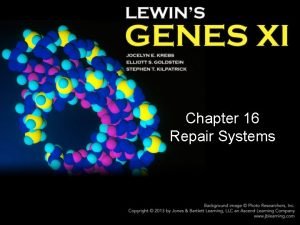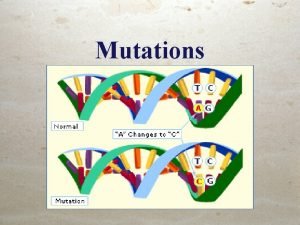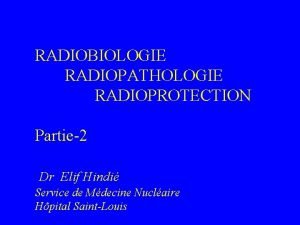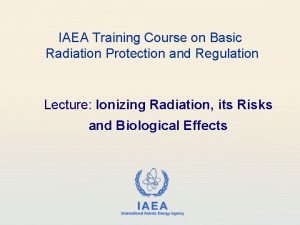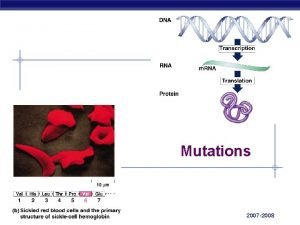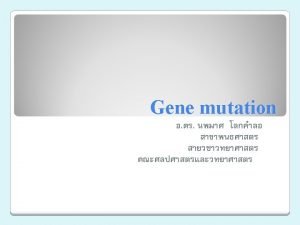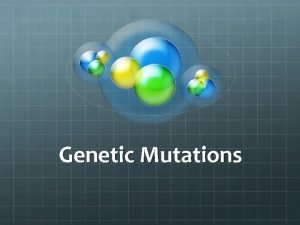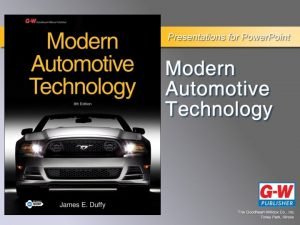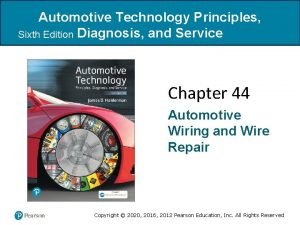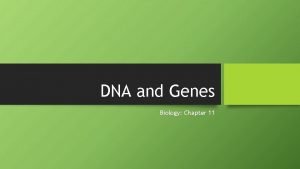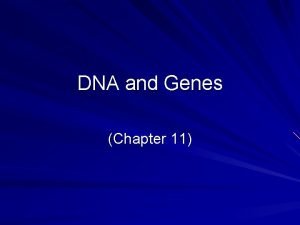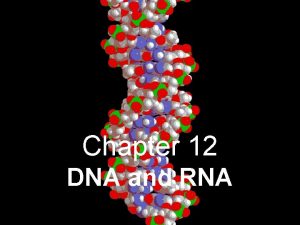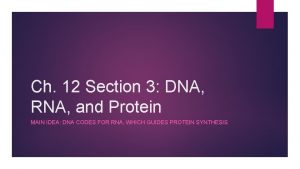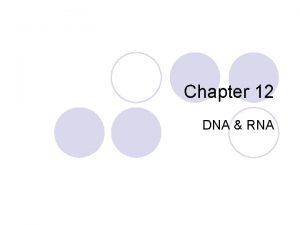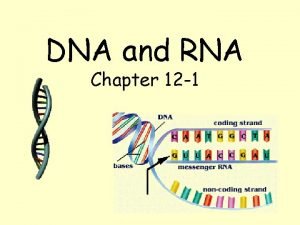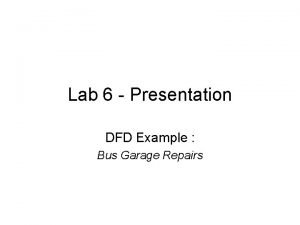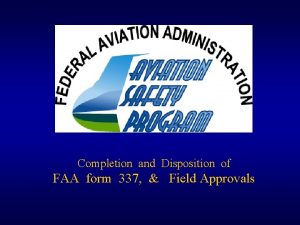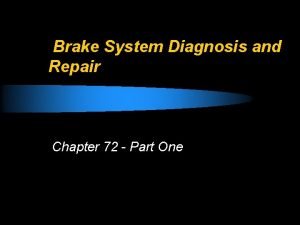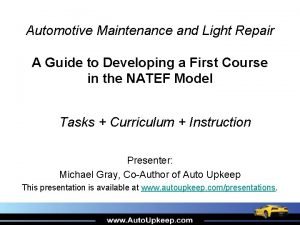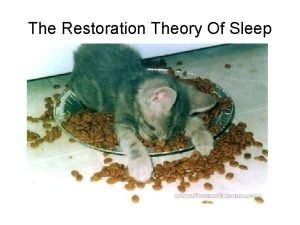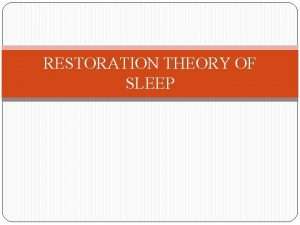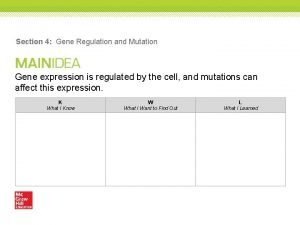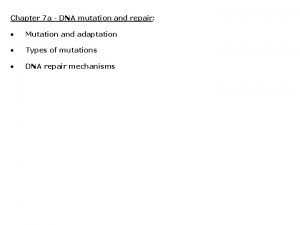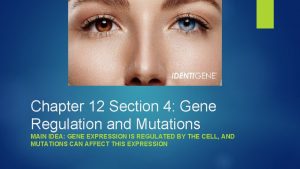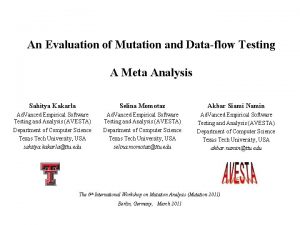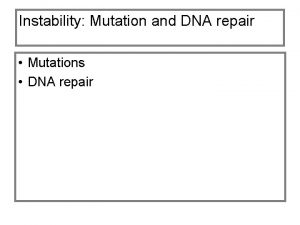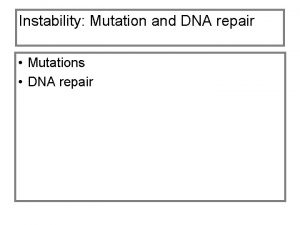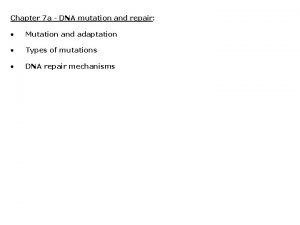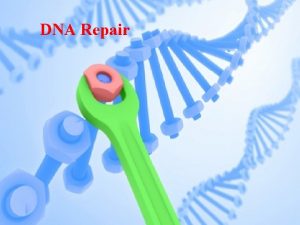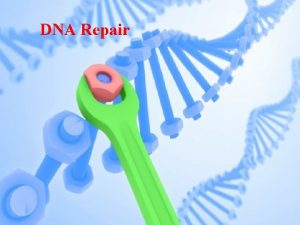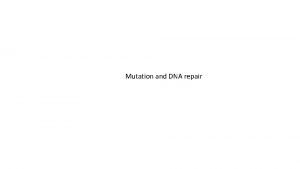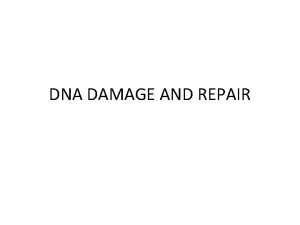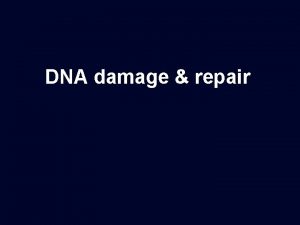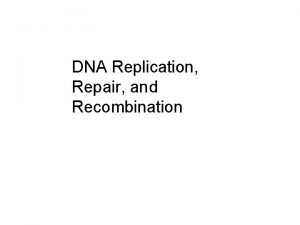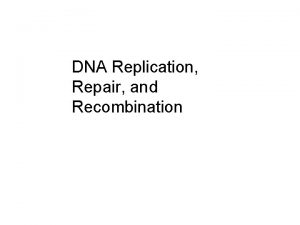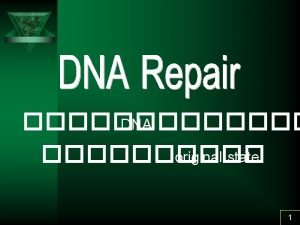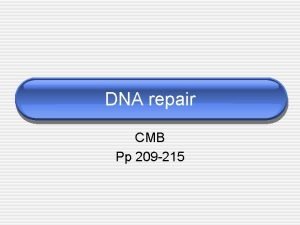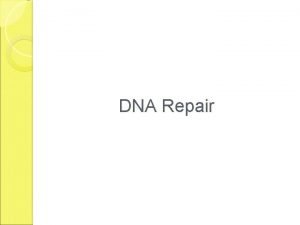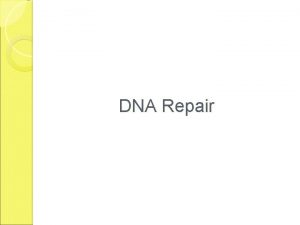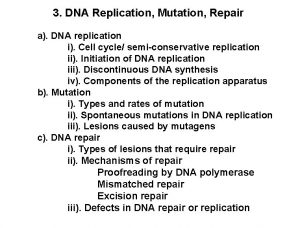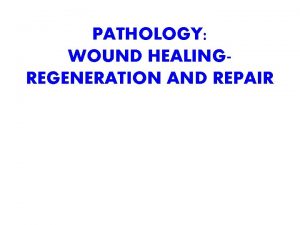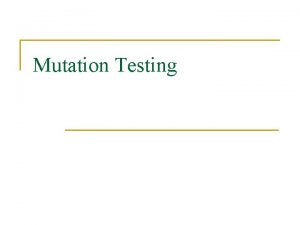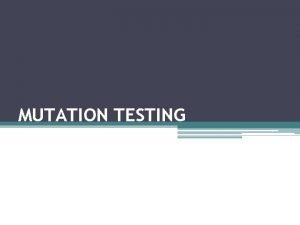Chapter 7 a DNA mutation and repair Mutation



































- Slides: 35

Chapter 7 a - DNA mutation and repair: • Mutation and adaptation • Types of mutations • DNA repair mechanisms

Mutation and adaptation: Jean-Baptiste Lamarck (1744 -1829) • Proposed “inheritance of acquired traits” ~1801. • Induction by the environment; also known as transformism, transmutation, or soft inheritance. • Examples: giraffes that acquire longer necks or athletes that build strong muscles pass these traits to their offspring. • In genetic terms, Lamarckism is the idea that environmentally induced mutations could be passed to the offspring.

Mutation and adaptation: Jean-Baptiste Lamarck (1744 -1829) • Ideas largely ignored or attacked during his lifetime. • Never won the acceptance and esteem of his colleagues and died in poverty and obscurity. • Today Lamarck is mostly associated with a discredited theory of heredity (Lamarckism persisted until 1930 s/1940 s). • Interest in Lamarck has resurged with discoveries in the field of epigenetics. • Epigenetics - heritable changes in gene expression or the phenotype caused by mechanisms other than changes in the underlying DNA sequence (≠ maternal effect).

Charles Darwin (1809 -1882) • Heritable adaptive variation results from random mutation and natural selection (1859, The Origin of Species). • Contrary to Larmarck, inheritance of adaptive traits does not result from induction by environmental influences. • But differential survival (selection) and heritable variation (arising from mutation in the DNA sequence). • Years following Darwin and rediscovery of Mendel resulted in controversy (until 1930 s/1940 s) about the relative importance of mutation and selection. • Largely resolved by theoretical and empirical work of Fisher, Haldane, and Wright (see chapter 21 lectures).

Experimental test of Lamarck’s “inheritance of acquired traits” Salvador Luria and Max Delbrück (1943) • An E. coli population started from one cell should show different patterns of T 1 resistance depending on which theory is correct. 1. Lamarck’s theory states that cells are induced to become resistant when T 1 is added; proportion of resistant cells should be the same for all cultures with the same genetic background. 2. Mutation theory states that random events confer resistance to T 1; duplicate cultures with the same genetic background should show different numbers of T 1 resistant cells.

Fig. 7. 2, Fluctuating populations of E. coli infected with T 1 phage. Luria and Delbrück (1943) Lamarck theory prediction: proportions or resistant cells are the same Mutation theory prediction: proportions are function of genotypes

What is a mutation? • Substitution, deletion, or insertion of a base pair. • Chromosomal deletion, insertion, or rearrangement. Somatic mutations occur in somatic cells and only affect the individual in which the mutation arises. Germ-line mutations alter gametes and passed to the next generation. Mutations are quantified in two ways: 1. Mutation rate = probability of a particular type of mutation per unit time (or generation). 2. Mutation frequency = number of times a particular mutation occurs in a population of cells or individuals.

Two types of point mutations: 1. Base pair substitutions. 1. Transitions • Convert a purine-pyrimidine to the other purine-pyrimidine. • 4 types of transitions; A G and T C • Most transitions results in synonymous substitution because of the degeneracy of the genetic code. 2. Transversions • Convert a purine-pyrimidine to a pyrimidine-purine. • 8 types of transversions; A T, G C, A C, and G T • Transversions are more likely to result in nonsynonomous substitution. Base pair deletions and insertions

Terminology describing mutations in protein coding sequences: Nonsynonymous/missense mutation Base pair substitution results in substitution of a different amino acid. Nonsense mutation Base pair substitution results in a stop codon (and shorter polypeptide). Neutral nonsynonymous mutation Base pair substitution results in substitution of an amino acid with similar chemical properties (protein function is not altered). Synonymous/silent mutation Base pair substitution results in the same amino acid. Frameshift mutations: Deletions or insertions (not divisible by 3) result in translation of incorrect amino acids, stops codons (shorter polypeptides), or readthrough of stop codons (longer polypeptides).

Fig. 7. 3, Types of base pair substitutions and mutations.

Fig. 7. 3, Types of base pair substitutions and mutations.

Fig. 7. 4, Effect of a nonsense mutation on translation.

Reverse mutations and suppressor mutations: Forward mutation Mutation changes wild type (ancestral) to mutant (derived). Reverse mutation (back mutation) Mutation changes mutant (derived) to wild type (ancestral). • Reversion to the wild type amino acid restores function. • Reversion to another amino acid partly or fully restores function. Suppressor mutation Occur at sites different from the original mutation and mask or compensate for the initial mutation without reversing it. • Intragenic suppressors occur on the same codon; e. g. , nearby addition restores a deletion • Intergenic suppressors occur on a different gene.

Intergenic suppressor genes: • Many function in m. RNA translation. • Each suppressor gene works on only one type of nonsense, missense, of frameshift mutation. • Suppressor genes often encode t. RNAs, which possess anti-codons that recognize stop codons and insert an amino acid. • Three classes of t. RNA nonsense suppressors, one for each stop codon (UAG, UAA, UGA). • t. RNA suppressor genes coexist with wild type t. RNAS. • t. RNA suppressors compete with release factors, which are important for proper amino acid chain termination. • Small number of read-through polypeptides are produced; tandem stop codons (UAGUAG) are required to result in correct translation termination.

Fig. 7. 5, t. RNA suppressor gene mechanism for nonsense mutation.

Spontaneous mutations differ from induced mutations: • Spontaneous mutations can occur at any point of the cell cycle. • Movement of transposons (mobile genetic elements, subject of next lecture) causes spontaneous mutations. • Mutation rate = ~10 -4 to 10 -6 mutations/generation • Rates vary by lineage, and many spontaneous errors are repaired.

Spontaneous mutations: Different types DNA replication errors Wobble-pairing T-G, C-A, A-G, T-C Normal pairing typically occurs in the next round of replication; frequency of mutants in F 2 is 1/4. GT pairs are targets for correction by proofreading and other repair systems. Additions and deletions DNA loops out on template strand, DNA polymerase skips bases, and deletion occurs. DNA loops out on new strand, DNA polymerase adds untemplated bases.

Fig. 7. 7, Mutation caused by mismatch wobble base pairing.

Fig. 7. 8, Addition and deletion by DNA looping-out.

Spontaneous mutations: Spontaneous chemical changes Depurination Common; A or G are removed and replaced with a random base. Deamination Amino group is removed from a base (C U); if not replaced U pairs with A in next round of replication (CG TA). Prokaryote DNA contains small amounts of 5 MC; deamination of 5 MC produces T (CG TA). Regions with high levels of 5 MC are mutation hot spots.

Fig. 7. 9, Deamination.

Induced mutations Radiation (e. g. , X-rays, UV) Ionizing radiation breaks covalent bonds including those in DNA and is the leading cause of chromosome mutations. Ionizing radiation has a cumulative effect and kills cells at high doses. UV (254 -260 nm) causes purines and pyrimidines to form abnormal dimer bonds and bulges in the DNA strands. Fig. 19. 10, Thymine dimers induced by UV light.

Induced mutations: chemical mutagens Base analogs • Similar to normal bases, incorporated into DNA during replication. • Some cause mis-pairing (e. g. , 5 -bromouracil). • Not all are mutagenic.

Fig. 7. 11 a, Mutagenic efffects of 5 -bromouracil

Fig. 7. 11 b, Mutagenic efffects of 5 -bromouracil

Induced mutations: Chemical mutagens Base modifying agents, act at any stage of the cell cycle: • Deaminating agents • Hydroxylating agents • Alkylating agents

Fig. 7. 12, Base-modifying agents.

Fig. 7. 12, Base-modifying agents (cont. ).

Induced mutations: chemical mutagens Intercalating agents: • Thin, plate-like hydrophobic molecules insert themselves between adjacent base-pairs, • Mutagenic intercalating agents cause insertions during DNA replication. • Loss of intercalating agent can result in deletion. • Examples: proflavin, ethidium bromide Fig. 7. 13


Detecting environmental mutations: Ames Test (after Bruce Ames) Ames Test is an inexpensive method used to screen possible carcinogens and mutagens. • Histidine auxotroph Salmonella typhimurium (requires Histidine to grow) are mixed with rat liver enzymes and plated on media lacking histidine. • Liver enzymes are required to detect mutagens that are converted to carcinogenic forms by the liver (e. g. , procarcinogens). • Test chemical is then added to medium. • Control plates show only a small # of revertants (bacteria cells growing without histidine). • Plates innoculated with mutagens or procarcinogens show a larger # of revertants. • Auxotroph will not grow without Histidine unless a mutation has occurred.

Fig. 7. 14, Ames test.

DNA repair mechanisms: Enzyme-based repair mechanisms prevent and repair mutations and damage to DNA in prokaryotes and eukaryotes. Types of mechanisms • DNA polymerase proofreading - 3’-5’ exonuclease activity corrects errors during the process of replication. • Photoreactivation (also called light repair) - photolyase enzyme is activated by UV light (320 -370 nm) and splits abnormal base dimers apart. • Demethylating DNA repair enzymes - repair DNAs damaged by alkylation. • Nucleotide excision repair (NER) - Damaged regions of DNA unwind are removed by specialized proteins; new DNA is synthesized by DNA polymerase. • Methyl-directed mismatch repair - removes mismatched base regions not corrected by DNA polymerase proofreading. Sites targeted for repair are indicated in E. coli by the addition of a methyl (CH 3) group at a GATC sequence.

Fig. 7. 16 Nucleotide excision repair (NER) of pyrimidine dimmer and other damage-induced distortions of DNA

Fig. 7. 17 Mechanism of mismatch correction repair
 Base excision repair
Base excision repair Rec a
Rec a Chromosomal mutation
Chromosomal mutation Proofreading and repair of a dna strand occurs during:
Proofreading and repair of a dna strand occurs during: Dna mutation
Dna mutation Dna mutation
Dna mutation Type of dna mutation
Type of dna mutation Dna mutation
Dna mutation Dna mutation
Dna mutation Coding dna and non coding dna
Coding dna and non coding dna Dna polymerase function in dna replication
Dna polymerase function in dna replication Bioflix activity dna replication lagging strand synthesis
Bioflix activity dna replication lagging strand synthesis What role does dna polymerase play in copying dna?
What role does dna polymerase play in copying dna? Dna and genes chapter 11
Dna and genes chapter 11 Power brake system
Power brake system Chapter 76 suspension system diagnosis and repair answers
Chapter 76 suspension system diagnosis and repair answers Peak and hold injector waveform
Peak and hold injector waveform Chapter 44 automotive wiring and wire repair
Chapter 44 automotive wiring and wire repair Chapter 11 dna and genes
Chapter 11 dna and genes Dna and genes chapter 11
Dna and genes chapter 11 Chapter 12 dna and rna
Chapter 12 dna and rna Chapter 12 section 3 dna rna and protein
Chapter 12 section 3 dna rna and protein A _________bond joins amino acids together.
A _________bond joins amino acids together. On and off
On and off Data flow diagram for parking management system
Data flow diagram for parking management system Faa 337
Faa 337 Brake system diagnosis and repair
Brake system diagnosis and repair Automotive maintenance and light repair answer key
Automotive maintenance and light repair answer key Repair and restoration theory of sleep
Repair and restoration theory of sleep Rrr of water bodies
Rrr of water bodies Repair and restoration theory of sleep
Repair and restoration theory of sleep Section 4 gene regulation and mutations
Section 4 gene regulation and mutations Types of substitution mutations
Types of substitution mutations Section 4 gene regulation and mutations
Section 4 gene regulation and mutations Mutation and adaptation
Mutation and adaptation Data flow and mutation testing
Data flow and mutation testing
